Master Plan Recommendations
Median Landscape and Fences
Median & Edge Landscape
The median and edge landscape create continuous visual landscape character along all the streets and major roadways in RVMD.
Rampart Range Road
With most of the District’s visitors coming from the north and entering the District through Rampart Range Rd, northern medians along Rampart Range provide a great opportunity to instill a positive first impression to the visitors, and to speak to the District’s brand as a natural and small-town community.
Careful treatment and intentional plant materials in the median landscape can help craft user experience on the road as visitors enter the District, and this can work as a quick-win for the District to implement.
Based on community feedback, residents are satisfied with the current state of the median and edge landscape in RVMD. Medians are generally in good condition and do not have major renovation needs. The current median holiday lighting program has been very successful and should be continued.
The median along Roxborough Primary School currently has a healthy mix of plants, with different plant massing and colors that provide interest along Rampart Range Rd. However, medians at the northern segment of Rampart Range Road are sparse and mostly covered with gravels and crusher fines.
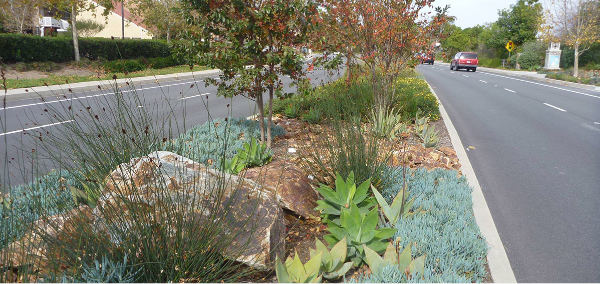
Example of median planting
Recommendations
Consider adding large plant clusters throughout the Rampart Range Rd median. Due to fast car traveling speeds along the road, large clusters of woody shrubs, tall grasses, and trees can help create a sense of place and provide visual interest to the users. Considering the width of the road and vastness of the contextual landscape, planting clusters should be at least 5ft to 10ft wide, and at least 30ft to 40ft long to provide substantial visual impact to the vehicular users. Use of native plants in road medians will conserve water use.
Edge landscape along Village Circle East and Village Circle West
Edge landscape is defined as the landscape between fences and curb line within neighborhoods. Edge landscape width and dimension vary depending on the location and may require different design strategies in different locations.
Most of the edge landscaping along Village Circle West and Village Circle East is currently in good condition, with bluegrass turf as the dominant landscape. Southern segment of Village Circle East does not contain any groundcover and is covered with gravels. Consider converting bluegrass turf and gravel to native plant species to provide visual interest and conserve water needs.
Recommendations
In addition to continuing current maintenance regime, the District can look for opportunities to reduce bluegrass turf areas and increase native landscape areas to mitigate maintenance needs and water use.
Consider phasing in enhanced landscape and plantings using native plants. At key intersections, such as Rampart Range Rd and Village Circle East, the District has installed native plants and perennials to signify entrance into the neighborhoods. Some intersection patches remain empty and covered in gravels, such as northern intersection between Rampart Range Rd and Village Circle West. Consider adding enhanced landscape featuring xeric and native plants to signal entrances into the neighborhoods.
When replanting or installing enhancements, arrange plants in large masses to reflect the scale of the road and create a visual effect for drivers passing by at higher speeds.
Enhanced Signage and Seasonal Lighting in Key Locations
Use flowering perennials and shrubs to accentuate major intersections and entry signs. Include planting colors as wayfinding signals and to further enhance the District’s natural brand.
Continue to use large slabs of rocks that reflect the hogback geology as signage and as visual features at key locations.
Use seasonal lightings in the medians to celebrate special holidays and events. Install new programmable lights that can change for different seasonal events and effects.

Examples of enhance landscape along edge landscape and intersections
Fencing
Currently, there are a total of 6 HOAs within the District. Not all HOAs have active governing Boards. Each HOA implements different fence styles, resulting in inconsistent fencing along Rampart Range Rd, the main vehicular road through the District.
In addition, years after initial installment, the fences experienced normal wear and tear, causing fencing qualities to vary greatly from segment to segment due to the different maintenance regime from different neighborhoods and HOAs.
Based on site observations, neighborhoods without active HOAs tend to have more variety in their fencing.
Recommendations
The various fencing presents incoherent identity to the people visiting the District. In order to provide consistent and strong District identity, the master plan recommends planting woody and perennial species in front of fences to provide consistency throughout the area. Consider working with HOAs and non-active HOA tracts along Rampart Range Rd to install similar family of fencing styles.
The following map and images illustrate existing fencing conditions and active HOAs within the District.
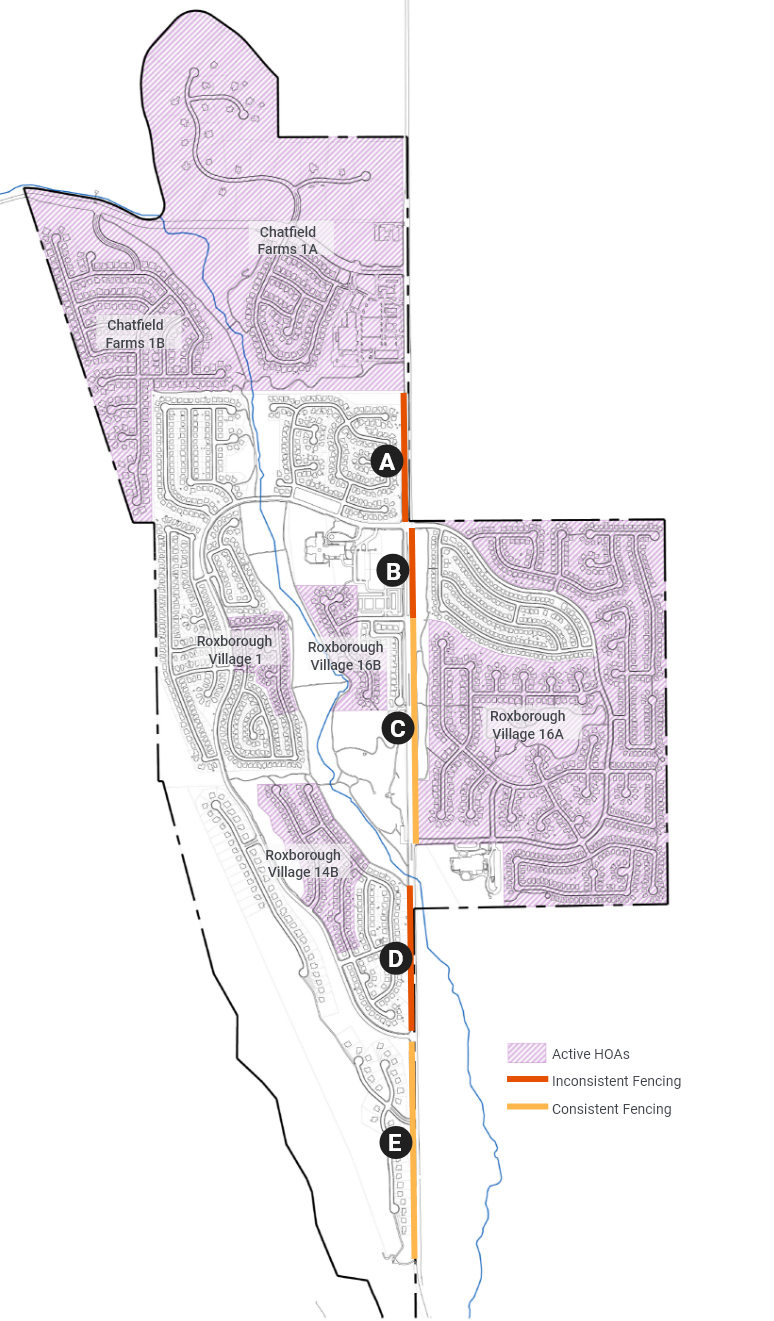
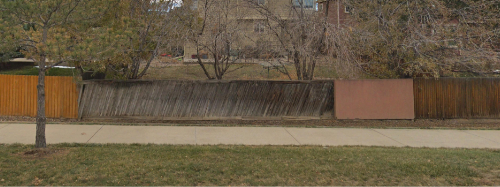
Fencing varies by property
Fencing varies by individual properties. It will be difficult to coordinate consistent fencing with individual property owners. Recommend using woody shrubs in front of fences to provide a consistent entrance experience.
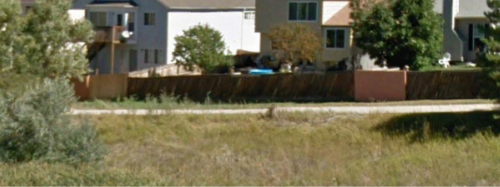
Fencing varies by property
Fencing varies by individual properties. It will be difficult to coordinate consistent fencing with individual property owners. Recommend using woody shrubs in front of fences to provide consistent entrance experience.
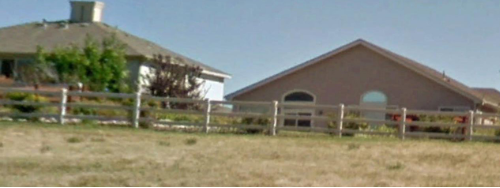
Consistent 3-Rail fencing
Opportunity to convert turf area into native plants to reduce maintenance and water needs. Plant clusters of native plants in front of fences.
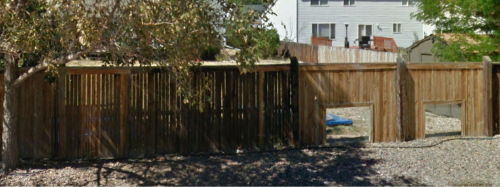
Consistent Board on Board fencing with little variety
Opportunity to convert gravel into native plants area to provide more visual interest. Introduce woody shrubs in this zone in front of fences to establish a consistent look.
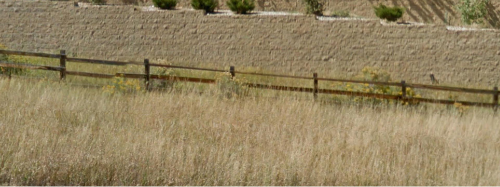
Consistent 2-Rail fencing
Plant clusters of woody shrubs and native plants in front of fences.